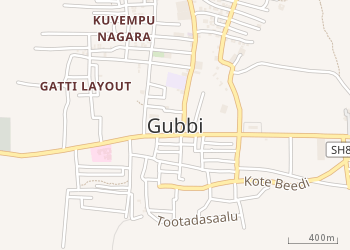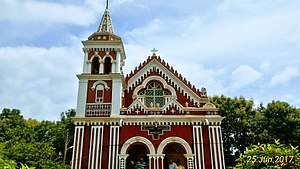Gubbi
Gubbi Town 20 km from Tumakuru and 90 km from Bengaluru along NH-206 (BH Road). Gubbi ULB Contains 17 Wards and equal number of Councilors. The population of the Gubbi Town is 18,457 as per Census 2011. The total area of the Town is 6.67 sq. km. Gubbi was earlier known by the name Amaragonda. Gubbi is famous for Gosala Sri Channabasaveshwara Swamy Temple of Veerashaiva sect[1] and Sri Chidambarashrama.[2]
 |

Gubbi | |
|---|---|
| Country | |
| State | Karnataka |
| District | Tumakuru |
| Talukas | Gubbi |
| Government | |
| • Type | Town Panchayath |
| Area | |
| • Total | 6.67 km2 (2.58 sq mi) |
| Languages | |
| • Official | Kannada |
| Time zone | UTC+5:30 (IST) |
| PIN | 572216 |
| Telephone code | 91-(0)8131 |
| Nearest city | Tumakuru |
| Lok Sabha constituency | Tumakuru |
| Vidhan Sabha constituency | Gubbi |
| Website | www |
Economy
Due to good transport infrastructure, it is a major business hub for neighboring small villages and towns. It has both rail station and National Highway (NH 206) connectivity which is a major attraction for people to settle or look for accommodation.
Thomas Hodson's Description of Goobbee, 1837
_-_Copy.jpg)
The Mission Station at Goobbe was started in April 1837, with Thomas Hodson and his wife moving to Goobbe. Initially they lived in tents, and after a while built mud cottages with thatched roof (see figure). The mud walls of the house were 6 ft. high, and the house had a few small rooms. The house was cool during the hot seasons, but leaked during the rains. Further, Hodson provides a description of the village life at Goobbe. Low flat lands well irrigated from a tank grew paddy. There were also large clumps of trees and large tracts of un-cultivated land, which was used as common pasture lands for sheep and cows. The shepherd boys usually had a hand made flute and played a sweet tone. Deer were common and were seen fleeting outside the mission house.
William Arthur's Description of Goobbee, 1847
Description of the Gubbi Town in the early / mid 19th century is narrated by William Arthur in his book A Mission to the Mysore, with Scenes and Facts Illustrative of India, its People, and its Religion, published in 1847
Goobbee town was located about 60 miles NW of Bangalore and had a population of between 6000-7000 people. The town people traded items such as coffee, grains, betel-nut, etc., which were purchased from Nuggur (Bednore) and sold in the markets of Bangalore and Wallajanuggur (Vellore). The residents were prosperous from this trade and town had its weekly market. At that time, the exchange rate for the British Indian Rupee was 2 British shillings (BINR 10 = British £1). Labour was cheap, costing as little as BINR 3 (6 British Shillings) a month. The cost of grains and spices and rent was minimal. Fuel used for cooking was cow dung. Generally 1 meal was cooked hot and eaten, and the other meal eaten cold. A man with BINR 10 was comfortable, one with BINR 20 respectable, one with BINR 50 was prosperous and one with BINR 100 was wealthy. However the cost of living and salaries were much higher in British Indian cities.
Goobbee like other Indian cities was surrounded by a mud wall, used to repel wild beasts and thugs. The term town (oor) applied only to places with both a market and a wall, village (hully) was one with a wall but not a market, hamlet (palya) consisted of houses with neither market or wall, and city (patna) was the seat of power. Villages had only 1 gate, towns 2 gates at opposite ends. The town of Goobbee had 2 main streets, intersected with minor streets. At one end of the mud fort, there lived the rich merchants. On the other side of the village lived the lower caste people, which was avoided by the higher caste. There was a clear de-markataion between the higher castes and the lower castes, with the higher caste people refusing to cross into what they considered as a polluted land (p. 189-191).[4]
William Arthur Memorial Church, Gubbi, 1904

The William Arthur Memorial Church is located on the Bangalore-Honavar Road at Gubbi Town, about 80 km from Bangalore. The church is painted turquoise blue and built in the Gothic style, being completed in 1904.[5][6] The church is named after William Arthur, an Irish Wesleyan missionary and Canarese Scholar, who served in Gubbi. The present structure replacing the old Gobbee Chapel, built by Thomas Hodson and William Arthur.[7]
Education
Gubbi has educational institutes which help students for education up to Bachelor's degree.
Major educational institutions are Bhoomi Public School, Priya English school, Government junior college, Stella Marys English school, Srinivasa school, Sri Chidambara ashrama, Greenwood International School, Shubhodaya English School, Government First Grade College,Gubbi.Government Junior College, Channabasaveshwara Institute of Technology (CIT)
Notable people
- Gubbi Mallanarya
- Gubbi Veeranna
- Sri Chi. Udayashankar (Kannada film lyricist/dialogues writer)
- Nirmalananda Swamiji
- G. S. Paramashivaiah
Hoblis in Gubbi Taluk
There are six hoblis and their headquarters in Gubbi taluk. They are following:
- Hagalavadi
- Cheluru.
- Nittur.
- Gubbi.
- Kadaba.
- C S Pura.
See also
- Mahalakshmi Temple,kadepalya,Gubbi
- Gosala Sri Channabasaveshwara Swamy Temple
- Thomas Hodson
- William Arthur
- William Arthur Memorial Church, Gubbi
- Hagalavadi
- Bukkapatna
- Gante Basavanna Temple,Naduvalapalya,Gubbi
References
- http://jjvlk.com/temples
- http://www.chidambarashrama.org/eng/aboutashram.htm
- Hodson, Thomas (1877). Old Daniel, or, Memoir of a converted Hindoo : with observations on mission work in the Goobbe circuit and description of village life in India. London: Wesleyan Conference Office. p. 78. Retrieved 23 November 2015.
- Arthur, William (1850). A Mission To The Mysore With Scenes And Facts Illustrative Of India, Its People And Its Religion. London: Partridge and Oakey. pp. 189–191. Retrieved 24 November 2015.
- Sharma, Poorna; Brinda (29 October 2012). "Back of the Blog – William Arthur Memorial Church in Gubbi". Word Press. Retrieved 14 December 2015.
- Sharma, Poornima (29 October 2012). "Back of the Blog - William Arthur Memorial Church in Gubbi". Travel To India. Retrieved 14 December 2015.
- Taggart, Norman W (31 July 1993). William Arthur: first among Methodists (1st ed.). Epworth Press. p. 13. ISBN 0716204894.
External links
| Wikimedia Commons has media related to Gubbi. |